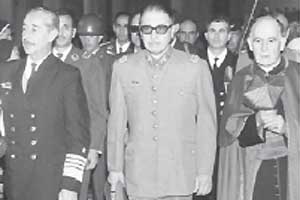While support for communist and socialist candidacies grew and was reaffirmed during the municipal elections of 1963, the interest for conservatives and liberals went down notoriously.
Therefore, a growing fear arose due to the imminent victory of the left’s candidate, Salvador Allende. The more conservative sectors of society speculated with the arrival of a socialist to La Moneda, reason for which the strategy of alliances was their only chance to prevent it.
This way, the political right supported Democratic Christian candidate Eduardo Frei Montalva for the elections of Spetember 4th, 1964. He obtained one of the highest votes attained to that date, with 56.09% of the votes, thus becoming the chosen person for simmering down populist spirits and installing the so called «revolution under freedom».
Social reformist
Eduardo Frei Montalva received the country at an unbeatable moment. He counted with the majority of the Senate; a stable economy thanks to the high prices of copper and an unthought-of popular support.
This was the best platform for implementing his popular government agenda, aimed at benefiting the have-nots and increasing citizens’ participation.
This way, the creation of community organizations was encouraged, like unions, neighborhood councils, mothers’ centers and co-ops, through the promulgation of the Neighborhood Council law in 1968, which legalized this type of associations.
This policy enabled, for example, for unions to nearly double their number of members in the six years this government lasted.
Important reforms were also made in education, aimed at improving teaching. In order to include younger children in public education, the Nursery law was enacted, integrating children from 1 to 6. Meanwhile, primary education took the name of basic education and it increased its duration to eight years. Secondary education was brought down to four years and it was dubbed middle education.
The latter was split into two areas, scientific-liberal arts and technical-professional.
However, one of his most ambitious projects was the «vigas maestras» (load bearing beams) project. For Frei Montalva it was vital for the development of the country and society as a whole to implement two important projects: the agrarian reform and the chilenization (nationalization) of copper. These were projects for laws that would change the fate of the country and leave a mark on the times.
During Alessandri Rodriguez’ government, the first light of an agrarian reform had already appeared. However, the real driving force was Frei Montalva with his promulgation of the Agrarian and Farming Union Reform in 1967. they enabled the redistribution of land through the expropriation of old latifundios, with the objective of making better use of the soil and even modernize them with new methods of exploitation and production. In 1970, there were already 3 and a half million expropriated hectares, which, in a first stage, were provisionally administered by farming organizations dubbed asentamientos (settlements).
The chilenization (nationalization) of copper was almost a need for the government of Frei Montalva. The country’s main source of wealth was, until that moment, exploited by foreign capitals, so the country could not fully enjoy the dividends. After two negotiations, the government obtained 51% of the stock options in the coppers deposits of Chuquicamata, El Teniente, La Exotica and Andina. It was necessary then, to create a new institutionality to manage the sales and resources, originating the Corporacion del Cobre (Copper Corporation) (Codelco). Based on this, plans were developed for expanding and improving the employees’ work conditions.
Ultimately, the chilenization (nationalization) of copper would become the most successful plan of Frei Montalva’s government because it achieved its objective. It eased the increase of the gross domestic product (GDP) and explained the surplus in the balance of payments, which in 1969 reached 168 million dollars.
Tension and radicalization
The presidential elections of 1970 were held under a climate of social unrest. There were frequent divisions in the party blocks and even the alliances were reorganized. The polarization was greater and greater and the country was clearly split into two tendencies, right and left. The first was supported by a new party led by the former conservatives and liberals, the National party. Meanwhile, the left put together their bid using the voices of socialists, communists, radical democrats and members of the Movimiento de Accion Popular Unitario (Unitary Popular Action Movement) (MAPU), creating the Unidad Popular (Popular Unity).
The confrontations were constant and political violence did not stop even days after the election, which was held on September 4th, 1970. Three candidates were in the race, al three with similar levels of support: Radomiro Tomic ran for the Christian Democracy; Jorge Alessandri Rodriguez for the Radical Democrat Party and the National party and Salvador Allende represented all of the parties grouped into the Unidad Popular.
As everyone expected, the results were close. So close that Salvador Allende obtained 1,070,334 votes, while his closest opponent Alessandri Rodriguez got 1,031,159. The fate of both candidates was to be decided in Congress; however, this time, a more radically leftist candidate was aspiring to power, reason for which the decision involved much more than only the votes of the members of parliament.
This way, negotiations and pressure began in support for one candidate or the other. It became necessary to establish an agreement between the Unidad Popular and the Christian Democracy for the latter party to give the victory to Allende; this not withstanding, both signed an agreement of constitutional guarantees, which established a series of untouchable rights and liberties during the installation of a Marxist government. This is how on October 24th, 1970, Salvador Allende was ratified by Parliament as president of the Republic, fulfilling the promise they made on November 4th of that same year.
Unidad Popular in power
Allende’s arrival to power hardly quieted down the country. There was a sector of society that distrusted his government agenda and he was under the watchful eye of the opposition.
However, Allende did count with the support of a large part of the population, which eagerly awaited the installation of his work plan.
One of his first interventions was in economics, establishing three great areas: the social area (made up by companies that would be owned by the State), the mixed area (in which the State would be the main, but not the only stockholder) and the private area (which only included small companied with little capital). But the project would soon encounter opposition from Congress, forcing the Executive to use a technicality that would allow the State to legally takeover any industry or company that was considered of vital importance to the country’s economy.
Social policy was also one of his greatest concerns, implementing improvements in health and education. He also created work programs for the unemployed and supported cultural projects for the people.
But despite favorable economic indicators, the stability achieved had only been attained though a great monetary expansion, which ended up with the devaluation of the currency and its resulting increase in inflation. Society would experience these issues with supply problems as well as the appearance of a market in which basic necessities were sold at astronomical prices.
Confrontation and division
September 11th, 1973 was the day scheduled by the Armed Forces to put an end to Salvador Allende’s government. As soon as the president heard of the movement of the troops, he headed towards the palace of La Moneda along with his collaborators; meanwhile, the high command of the Army and the Air Force, Augusto Pinochet and Gustavo Leigh, were coordinating military actions along with admiral Jose Toribio Merino and the general director of Carabineros Cesar Mendoza.
They would all make up the later government junta (assembly). The military forces deployed in different areas of the country soon defeated Allende’s followers, taking control of the country. Meanwhile, inside la Moneda, the president refused to leave the government palace; this was all the justification needed for two Hawker Hunter airplanes coming from Concepcion to bomb the government’s headquarters, which soon caught on fire. The confrontations continued until the military went in and took total control of La Moneda; minutes earlier, Salvador Allende had made the decision to commit suicide.
Military control
After the coup d’état, control of the country was taken over by the Armed Forces. A great part of the power fell into the hands of the military, who reorganized the institutions and designated Augusto Pinochet as supreme head of the Nation on June 26th, 1974.
Later, in the month of December, he would take on the title of president of the republic. Meanwhile, Congress was abolished and the legislative function was taken on by the military junta (assembly).
The Constitution was likewise suspended, and a great portion of civil liberties were oppressed by a series of measures that wanted to eliminate political activity and put and end to any revolutionary outburst in the country. This is how a dictatorship was installed that would last 17 years.
One of the main changes introduced during this period was the economic model, which is still in force in the country today. In order to achieve it, it was necessary to stabilize the economy. Therefore, a neo-liberal model was applied to the Chilean economy, which consisted on respecting the private property of the means of production, decreasing State control over companies. In addition, the currency was changed (from escudo to peso) and import and export fees were lowered.
A new pension system was also created based on individual capitalization, in which each worker saves 10% of their salary every month in order to finance their pension at the end of their work life. These funds would be managed by private bodies.
In 1980, the military regime petitioned the drafting of a new Constitution. Its objective would be to ensure the presence of the Armed Forces in the national political stage and in the Executive power, as well as supporting the continuity of the measures implemented up to that date. This way, the Constitution of 1980 established a presidential government regime, the creation of the National Security Council, designated senators and the binominal electoral system, among other measures. It also set 1988 as the deadline for the end of the military government.
Unrest and change
During the last years of the military government, social unrest increased. Despite the fact that restrictions to civil liberties continued, discontent motivated the population to head to streets and protest. National strikes and subversive acts by leftist groups completed the scenario the country was going through, which called for a switch in the political actions of the military.
Due to this, the government grew closer to a few opposition parties. In addition, the political right was also reorganized, originating new parties like the Independent Democratic Union (UDI) and National Renovation (RN).
In 1987, the Organic Law of Political Parties was promulgated, which would make these groups legal again and restore electoral records.
There was consensus when it came to looking for mechanisms that promoted understanding in a country that had lived in absolute division for several years.





